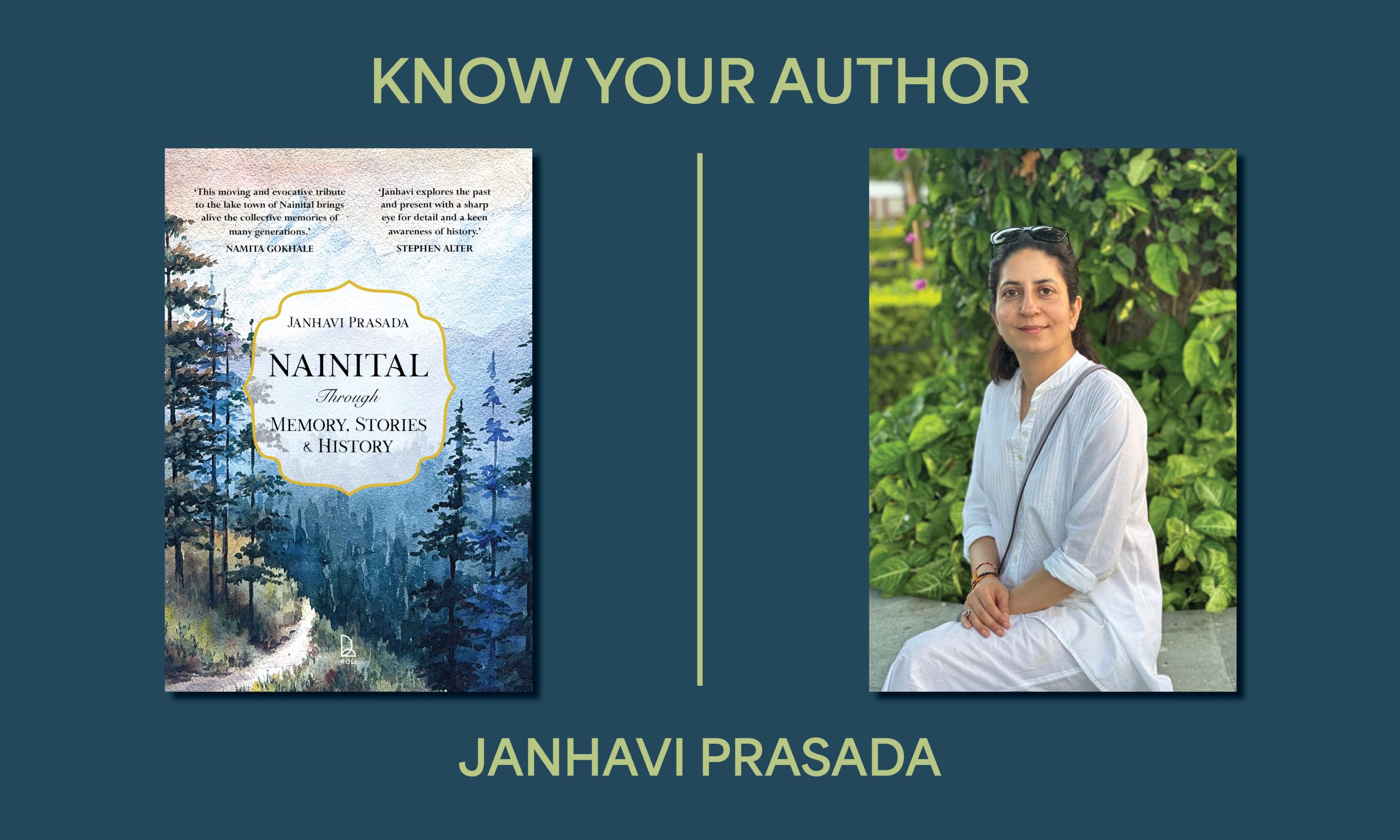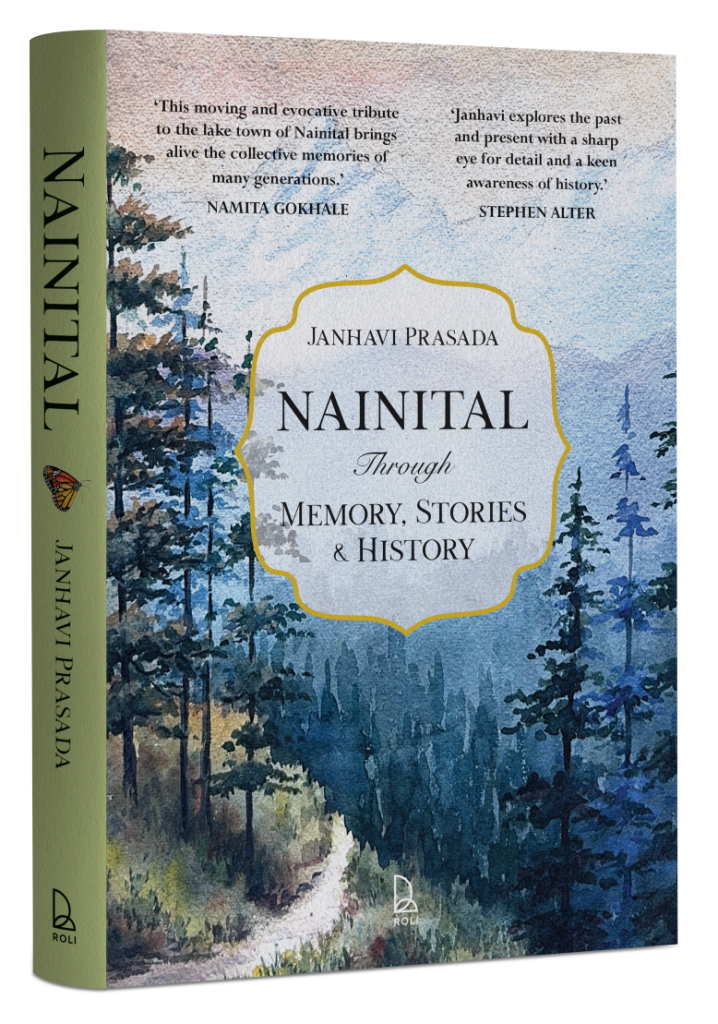In Nainital: Through Memory, Stories & History, Janhavi Prasada traces the town’s layered history, beauty, and the quiet intimacy of its people and places. Offering glimpses of life around the shimmering lake, its colonial legacies, indigenous foods and trails deep into the Deodar forests – complemented by fellow Nainital native Digvijay Singh’s evocative illustrations, this ode to the town paints a portrait of a place that is at once rooted in memory and timeless in spirit. Here is a candid interview we conducted with the author.
1. Nainital has been written about in travelogues and histories before. What did you feel was missing from existing literature that you wanted to capture?
Each century, each decade has its history and transitions. I felt the existing literature on Nainital called for a reset. No one from my generation has written on the hill-town, its people, places and ever-changing landscape. I have gathered the memories of five decades and woven them into a present that is changing swiftly, as is the way of the living world.
In the last decade, a deep bond came to surface when I set aside my journalistic career to live in the lap of the lesser Himalayas. My childhood was spent here, with my grandmother, my brother and cousins. I went to school here till 5th grade. But the last decade is when I experienced the natural world around me with a lot of awareness, read Gandhi-centric literature, wrote a graphic novel on him – this process brought me closer to my roots. From there emerged a sense of giving back to the land and the community. This book is a part of that. It is especially for the Nainital youth: to remind them of a pride that comes from being rooted in this gem of a town, and awaken a both a sense of belonging and of gratitude, so that they remember to treat it with care and compassion.
3. In your research, did you come across any forgotten stories or archival gems that surprised you?
Lots. My family bought Abbotsford from the British in 1906 and until the last decade I only knew our home as Prasada Bhawan. I discovered it was called Abbotsford, inspired by Sir Walter Scott’s estate in Scotland. The property agent who facilitated the transfer of rights to my great-grandfather Pandit Jwala Prasada was James Jim Corbett. I have a receipt signed by him – 14,500/- for the entire hill in 1906.
George Orwell’s parents were married in Nainital.
The famous Hungarian artist who was one of the first to make a live portrait of Mahatma Gandhi – Elizabeth Sas Brunner is buried in the St John’s In the wilderness Church
The Aligarh Dairy was established by a Swedish dairy expert Edward Keventer. Today Keventers is a brand to reckon with world over.
Many a scandal, secrets and escapades came out during research, but those are best left untouched.
I think change is inevitable and important as long as it is done mindfully keeping the culture, aesthetics and infrastructure of the town intact. One of the challenges for Nainital, is to manoeuvre the tourist crowds according to the carrying capacity of the hill town. We need stricter rules on construction, encroachments, hotel room carrying capacity, parking space, more pedestrian-friendly access.
Our churches are not in the best condition but better off than the other colonial structures that are falling apart or have undue construction around them.
The lake is the life line of the town. A decade ago, the local citizens marched along the lake asking for the dying lake to be revived and cleaned. Today it is one of the cleanest water bodies around – providing livelihood to more than 200 boatmen. It is a small town with over a hundred thousand residents, and it has the potential to be turned into a model hill station.
5. As a writer, what does your creative routine look like? Do you have a special writing spot, perhaps even in Nainital itself?
Yes, Nainital is where all my writing happens. The minutes before sunrise –when the sky glows and the first golden ray reaches my bedside – are my cue to rise, brew some Khawa, and write before the day’s noises creep in. My writing desk lies besides a French window, which faces the imposing range of Cheena peak dotted with Himalayan cypress. It looks out onto the garden where langurs and Khaleej pheasants prance around. I can reach out to branches of the walnut trees from the window, and often I am distracted by the hooting of an Asian Barred Owlett – a permanent resident at Abbotsford, or the constant knock of Yellow Nape Woodpecker.
6. If you could invite any three historical or literary figures to experience Nainital with you, who would they be and why?
William Wordsworth: We would exchange notes on his lake – Lake Windermere in Scotland and my lake, Nainital Lake in India. We would sit by the meadow and create nature poetry, walk in the thick of the Deodars and take in the fragrances of the forests.
Rabindranath Tagore: To ask him why he never visited Abbotsford since his niece, my great grandmother Purnima Devi nee Sudakshina Tagore, had a summer home in Nainital. I would spend time understanding how to bring about a cultural renaissance in the hills, where the talent of the earlier generations is fading for the lack of mentors like him, who once shared their life’s work so generously.
J. K. Rowling: She could weave another version of Harry Potter – maybe a desi Hari Potter. We’d visit old schools, churches, graveyards, create fairy tales inspired from scenic walkabouts like Camels Back, Dorothy’s Seat and bask by the lakeside watching the Linton Hope Rafter Yachts sail by in the misty lake – until a swarm of witches came swooping past on their brooms.
7. You are the fourth generation of your family to call Naintal your home. Do you believe places remember people? How does Nainital remember you, your family, or its past residents?
Places do remember people but storytelling brings them alive for everyone. That is why every book written on Nainital, from P. Barron’s Wandering in the Himmala written in 1844 to mine, nearly two centuries later, becomes a treasure that keeps people, places and memories alive.
My family has been part of this region since 1906. Our rootedness to the region since five generations has given us an identity that we hold with pride and grace. Through generations we have been able to contribute of the social fabric of the region. We know almost 50 percent of the households of Nainital, for three generations if not more.
8. What is one tradition or local custom of Nainital that you cherish and fear might disappear with time?
Walking. As is with all hill stations, Nainital was a pedestrian town. The culture of walking was ingrained in us. But now there is no space, with vehicles snatching away our right-of-way. That’s why I find my peace walking around the higher reaches of the lake town where forest trails and Himalayan views take you back in time.
9. What is your favourite thing about living and working in Nainital?
The quiet and the beauty of the landscape. It makes you focused, highly creative and exponentially productive. Of course, there has to be hi-speed internet to complement it.
10. What message or emotion do you hope readers, especially those who have never visited Nainital, carry with them after finishing your book?
History must be preserved and retold through the art of storytelling to keep it alive. This book is an invitation for a reader to slow down. Through this book, I hope they journey from the Raj to now – discover the joy of a child growing up in the hills, a teenager free and wild, and an adult working to protect the beauty of the land and community that shaped who I am today.


